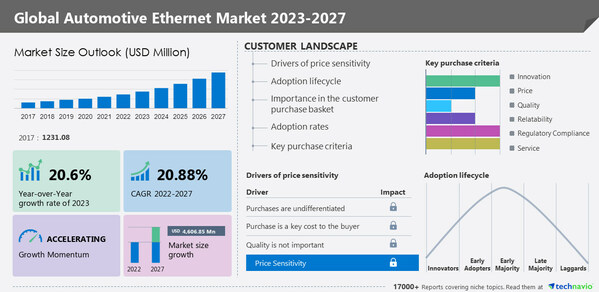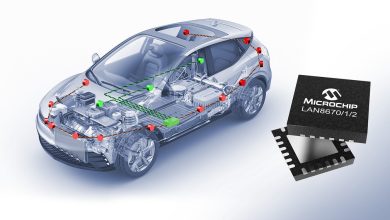Technavio: Automotive ethernet market to grow by US$ 4.6 billion from 2022 to 2027

NEW YORK, June 19, — The global automotive ethernet market size is forecast to increase by USD 4,606.85 million from 2022 to 2027, at a CAGR of 20.88%, according to the recent market study by Technavio. The growth of the market will be driven by the increasing demand for high bandwidth and lightweight materials, rising demand for driver assistance systems, and future-proof technology.
Technavio has extensively analyzed 15 major vendors, including ACTIA PCS, Amphenol Communications Solutions, Broadcom Inc., Cadence Design Systems Inc., DASAN Networks Inc., Infineon Technologies AG, Intrepid Control Systems Inc., Keysight Technologies Inc., Marvell Technology Inc., Microchip Technology Inc., Mouser Electronics Inc., NEXCOM International Co. Ltd., NXP Semiconductors NV, Realtek Semiconductor Corp., Rohde and Schwarz GmbH and Co. KG, Spirent Communications Plc, System on Chip Engineering S.L., TE Connectivity Ltd., Tektronix Inc., and Texas Instruments Inc.
Key Benefits for Industry Players & Stakeholders –
- The report offers information on the criticality of vendor inputs, including R&D, CAPEX, and technology.
- It also provides detailed analyses of the market’s competitive landscape and vendors’ product offerings.
- The report also provides a qualitative and quantitative analysis of vendors to help clients understand the wider business environment as well as the strengths and weaknesses of key market players. Data is qualitatively analyzed to categorize vendors as pure play, category-focused, industry-focused, and diversified; it is quantitatively analyzed to categorize vendors as dominant, leading, strong, tentative, and weak.
Automotive ethernet market - Segmentation
The market is segmented by vehicle type (passenger cars and commercial vehicles), Application (Cameras and ADAS, Infotainment, Diagnostics, and Network backbone), and Geography (APAC, North America, Europe, South America, and Middle East and Africa)
- The market share growth of the passenger cars segment will be significant during the forecast period. The electrification of mechanical components in passenger vehicles has led to the rapid integration of advanced features related to safety, security, propulsion, connectivity, and environmental performance. As a result, the number of electronic control units (ECUs) in passenger vehicles has significantly increased. Furthermore, Automakers are placing significant focus on enhancing the safety standards of passenger cars, which has led to the adoption of advanced safety functions requiring secure communication protocols. Hence, these factors will drive the passenger segment during the forecast period.
- APAC is estimated to contribute 44% to the growth of the global market during the forecast period. The adoption of advanced driver-assistance systems (ADAS) in vehicles is the key factor that will drive the growth of automotive Ethernet in the APAC region during the forecast period. China is expected to lead the way in the adoption of ADAS systems within the region. The increasing penetration of connected technologies and ADAS across all vehicle segments signifies a positive trend in the automotive industry in the country. Moreover, the rising demand for premium audio and video services in the automotive sector is expected to drive increased adoption of Ethernet AVB in the APAC region during the forecast period.
Automotive ethernet market – Market Dynamics
Key Drivers
The increasing demand for high bandwidth and lightweight materials notably drives market growth. The inclusion of various sensors in modern vehicles has resulted in the advancement of complex safety systems. These systems depend on interconnections and communication with the electronic control unit (ECU). However, traditional wiring harnesses and connectors are insufficient in meeting the bandwidth requirements for high-speed data transmission. To address this challenge, original equipment manufacturers (OEMs) have turned to shielded coaxial cables offering higher bandwidth capabilities than unshielded cables. Furthermore, as the ethernet industry experiences widespread adoption, the cost of materials is expected to decrease due to high competition and economies of scale. Hence, these factors are expected to drive the market growth during the forecast period.
Major Trends
The use of ethernet technology to establish the backbone network in vehicles is the major trend shaping the growth of the automotive ethernet market. Address-based messaging is an important feature of ethernet that positions it as a popular choice for the backbone networks of vehicles. This messaging approach involves assigning a source and destination address to each data packet. Ethernet switches use these addresses to accurately deliver the data packets to the intended recipients within the network. This is the main reason for many manufacturers developing vehicle backbone networks with the help of the ethernet. Hence, the increasing use of ethernet in future cars will drive the growth of the market during the forecast period.
Significant Challenges
Skepticism about adopting ethernet in vehicles is the major challenge restricting the market growth. The main factor restricting the adoption of new technology by OEMs is the initial high cost of implementation. With intense competition and rising material and labor costs, OEMs are experiencing decreasing profit margins. As ethernet technology is relatively new to the automotive sector, many OEMs are waiting for other industry players to implement it before making their own decisions.
Furthermore, OEMs are unable to evaluate the risks associated with the implementation as ethernet is still more expensive than CAN and LIN. Hence, these factors are preventing OEMs from adopting ethernet in vehicles which will restrict the market growth during the forecast period.


